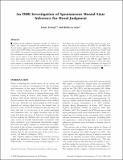An fMRI Investigation of Spontaneous Mental State Inference for Moral Judgment
Author(s)
Saxe, Rebecca R.; Young, Liane
DownloadSaxe_An fMRI.pdf (221.1Kb)
PUBLISHER_POLICY
Publisher Policy
Article is made available in accordance with the publisher's policy and may be subject to US copyright law. Please refer to the publisher's site for terms of use.
Terms of use
Metadata
Show full item recordAbstract
Human moral judgment depends critically on “theory of mind,” the capacity to represent the mental states of agents. Recent studies suggest that the right TPJ (RTPJ) and, to lesser extent, the left TPJ (LTPJ), the precuneus (PC), and the medial pFC (MPFC) are robustly recruited when participants read explicit statements of an agent's beliefs and then judge the moral status of the agent's action. Real-world interactions, by contrast, often require social partners to infer each other's mental states. The current study uses fMRI to probe the role of these brain regions in supporting spontaneous mental state inference in the service of moral judgment. Participants read descriptions of a protagonist's action and then either (i) “moral” facts about the action's effect on another person or (ii) “nonmoral” facts about the situation. The RTPJ, PC, and MPFC were recruited selectively for moral over nonmoral facts, suggesting that processing moral stimuli elicits spontaneous mental state inference. In a second experiment, participants read the same scenarios, but explicit statements of belief preceded the facts: Protagonists believed their actions would cause harm or not. The response in the RTPJ, PC, and LTPJ was again higher for moral facts but also distinguished between neutral and negative outcomes. Together, the results illuminate two aspects of theory of mind in moral judgment: (1) spontaneous belief inference and (2) stimulus-driven belief integration.
Date issued
2009-04Department
Massachusetts Institute of Technology. Department of Brain and Cognitive SciencesJournal
Journal of Cognitive Neuroscience
Publisher
MIT Press
Citation
Young, Liane, and Rebecca Saxe. “An fMRI Investigation of Spontaneous Mental State Inference for Moral Judgment.” Journal of Cognitive Neuroscience 21.7 (2009): 1396-1405. © 2011 The MIT Press
Version: Final published version
ISSN
0898-929X
1530-8898